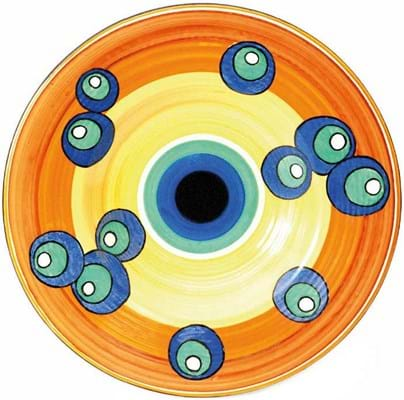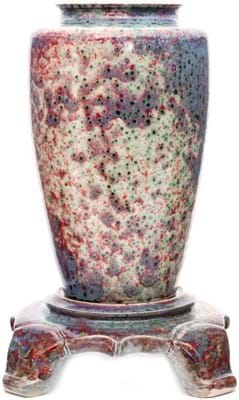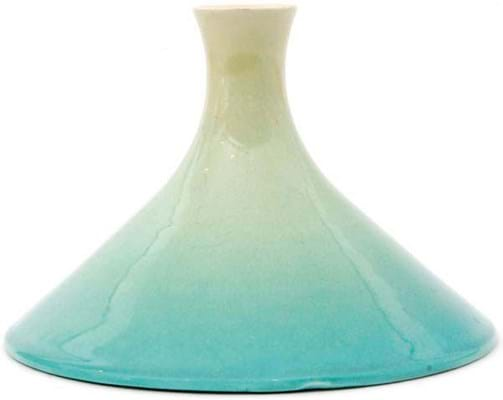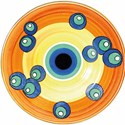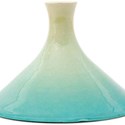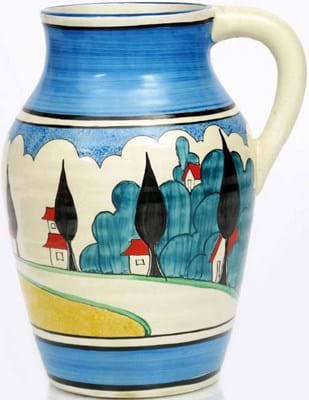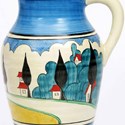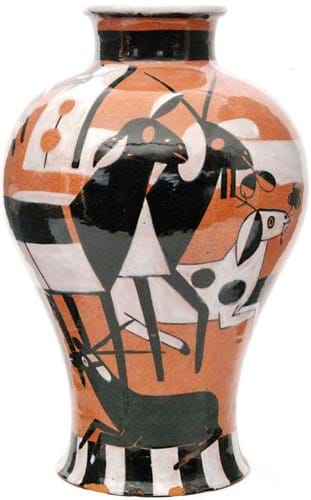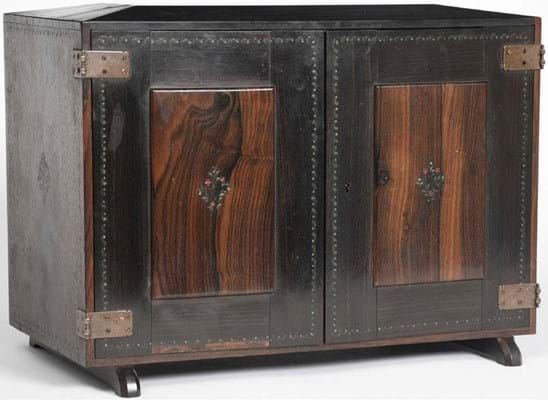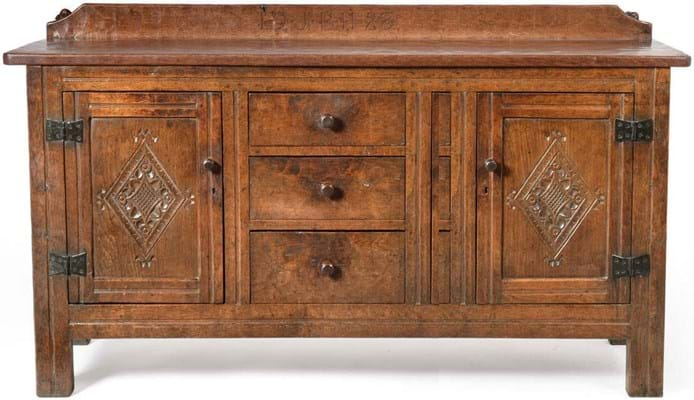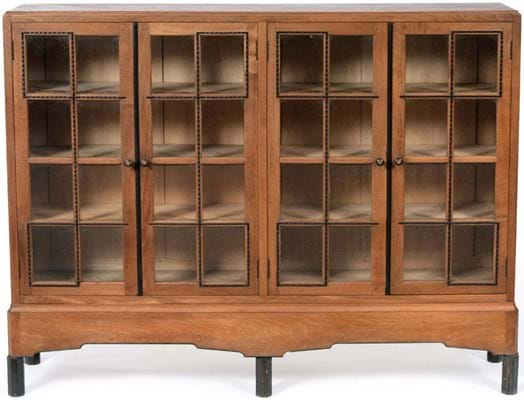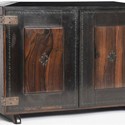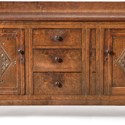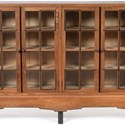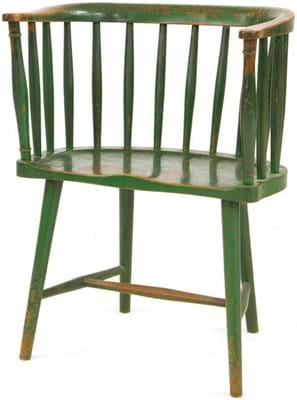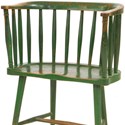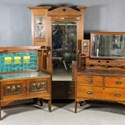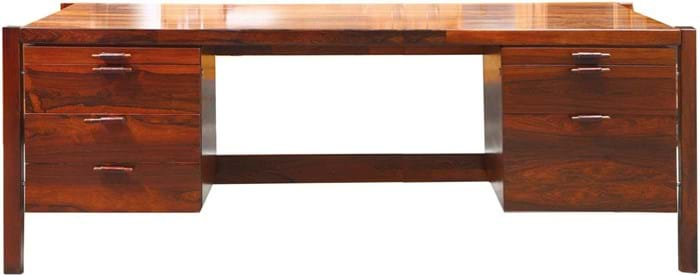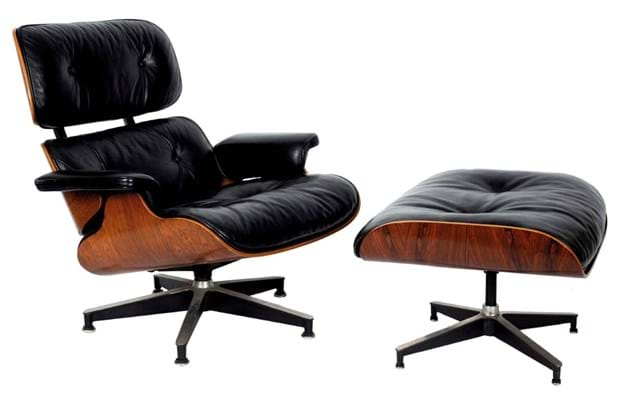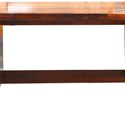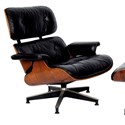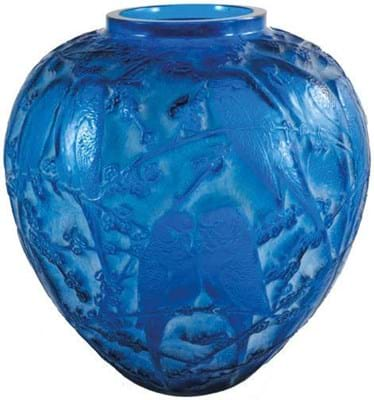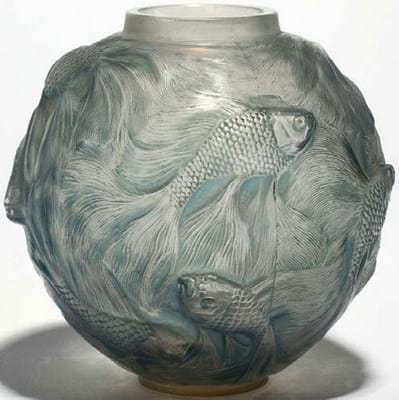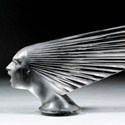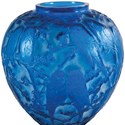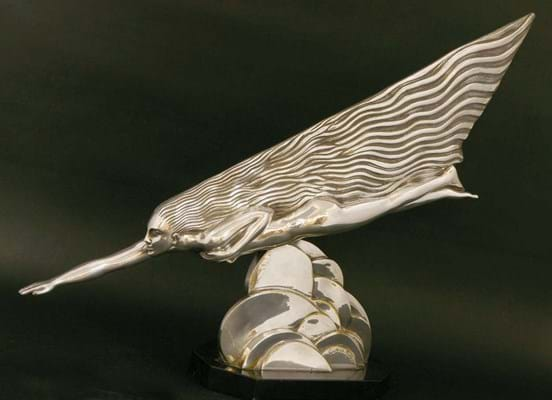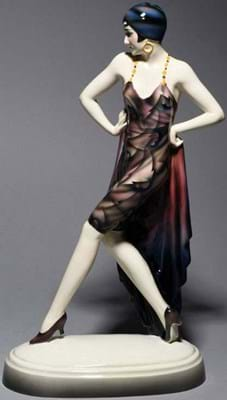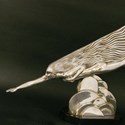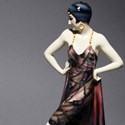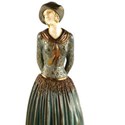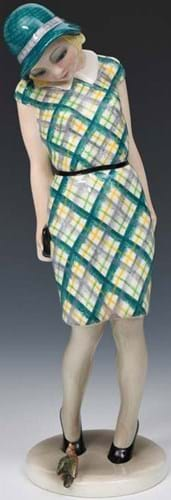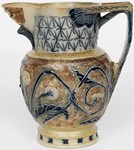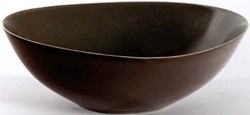Very much to current fashion, sales with titles on theme of late 19th and 20th century ‘Design’ theme have become mainstream for regional auction houses.
A number of such sales this autumn provided a snapshot across the wide-ranging market.
Ceramics
Ceramics have remained a feature of many such sales but it is very much a case of the best and the rest in today’s generally quiescent market.
Typical is the current trade in Clarice Cliff pottery.
At Fieldings’ (20% buyer’s premium) sale in Stourbridge on October 5, Clarice accounted for about 45% of the 340-lot ceramics section. Of these, an 18in (46cm) diameter charger was in a different league. “One of my favourite Clarice finds in over 30 years,” is how Fieldings director and specialist Will Farmer rated the Bowling pattern charger. “It had been in the vendor’s family since new and it was in fantastic condition.”
Dated c.1929, Bowling is one of the rarest of Clarice abstract designs. Fewer than 10 pieces are known and the design had never previously been seen on a charger.
Nevertheless, the slump in Clarice prices since the 2003 high point, when Christie’s South Kensington sold a charger in the May Avenue pattern at £34,000, kept the Stourbridge estimate down to £5000-7000. But it was no real surprise when a dealer versus collector battle took it to £11,000.
A piece of May Avenue came up at Woolley & Wallis (25% buyer’s premium) in Salisbury on October 16. This 9½in (24.5cm) single-handed ‘Isis’ vase with blue and black bands went at a lower-estimate £5000 to a UK collector new to the rooms.
A favourite lot here was a Stamford-shape teapot in the Circle Tree pattern. It more than doubled top hopes in selling to an American buyer at £3500.
The great Barlows
Those other great female ceramicists from the earlier period, Hannah and Florence Barlow, met a mixed response at Fieldings.
Reflecting the fall in Doulton Lambeth wares generally, a pair of 12in (31cm) tall, 1874 stoneware vases by Hannah failed to sell against hopes of £1000-1500.
By contrast a late-19th century, 6in (15cm) tall stoneware Isobath inkwell by Florence soared above an experienced vendor’s expectations.
Pâte-sur-pâte decorated to the body with two bats in flight and two owls resting to a branch before a full moon, it was pitched at £400-600 but sold at £4800.
The form is important: patent Isobath inkwells such as this appeal to a number of niche collecting areas.
A bigger surprise at Stourbridge was the outstanding Christopher Dresser piece.
One of 27 lots by the great man, mainly selling for two-figure or low-three figure sums, this was a late-19th century, 4½in (11.5cm) tall Linthorpe Pottery vase on a spreading circular foot. Inscribed with the signature Chr. Dresser and guided at £70-100, it sold on thesaleroom.com at £4100.
It was one of a handful of strong prices for Dresser Linthorpe that reached a new level last month when Lyon & Turnbull sold a Fijian-inspired sake flask for £17,000 (see last week’s News pages).
William De Morgan was represented at a number of autumn sales, including the 1700-lot Fine & Decorative event at Kingham & Orme (20% buyer’s premium) on October 3-5 – the Evesham auction house’s biggest sale to date.
Best of five De Morgan lustre items was a c.1890, 9½in (24cm) double lustre dish painted with a deer, lizards and a tree monogrammed by designer Charles Passenger, which took a mid-estimate £2800.
One of De Morgan’s best-known animal tiles, the c.1880, 6in (15.5cm) square pink lustre Flamingo, went at five times the conservative top estimate, selling at £2400.
The same bid took a set of six nursery rhyme themed tiles Walter Crane designed for Minton c.1870. Some bearing Crane’s monogram, the 8in (20.5cm) tiles were estimated at £400-600.
The Moorcroft market is generally soft. However, at Kingham & Orme a couple of the 140-odd pieces by the factory stood out.
A c.1930 Flambé Cornflower vase, 12½in (32cm) high with impressed marks and underglaze William Moorcroft signature, doubled mid-estimate at £1900.
The earliest of 43 Pomegranate pattern pieces was a c.1910, 8½in (22cm) footed trumpet vase in the rarer green glaze. Made for James MacIntyre and bearing Moorcroft’s underglaze green signature, it went a shade above expectations at £1300.
Best among the 23 pieces at Woolley & Wallis were two yellow, red, blue and green on a celadon ground Claremont pattern pieces Moorcroft designed for Liberty. A 9½in (24.5cm) tall flaring cylindrical vase and a 12in (30cm) wall plaque each sold at the lower-estimate £2000.
A more positive reaction greeted Ruskin material.
At Fieldings a high-fired shouldered ovoid vase with impressed marks and date, 1926, was offered with the original glaze-matched Oriental-style stand. Decorated with a lilac, lavender, red and copper oxide glaze, it doubled the upper estimate in selling at £4100.
Also going well above hopes was a c.1925 high-fired Ruskin cylindrical shouldered vase at Kingham & Orme. Standing 10in (25.5cm) high, with twin-angled handles, it took £2800.
Dominated by British material as they were, the ceramics sales also included European contributions. Best of these was a 15¼in (39cm) hand-thrown vase at Fieldings impressed with the Wiener Werkstätte mark and attributed to Josef Hoffmann.
This had been a lucky find for the vendor in South Africa who had spotted its potential – and a design of stylised black and white goats and sheep – beneath a coat of white gloss paint. It had some slight damage to the foot but went at a mid-estimate £4500.
Furniture
A strong representation of Cotswolds School furniture was headed by a small 18in (46cm) ebony and macassar desk-top cabinet by Peter Waals with painted decoration by Louise Powell sold by Woolley & Wallis on October 16.
Waals knew Powell and her husband Alfred when they all worked with Ernest Gimson from 1901 at the Daneway workshop. Waals employed their talents when, following Gimson’s death in 1919, he set up his own workshops at Chalford.
The macassar panels to this cabinet were painted with foliate bands and a central red flower wreath. The interior of the doors and nine small drawers they enclosed were also painted with white and red flowers. Pitched at £6000-9000, it sold at £19,000 to a UK collector.
Close behind in price terms was Sidney Barnsley’s ivory-inlaid walnut double bookcase commissioned shortly after 1919. Standing 7ft 5in tall x 7ft wide (2.27 x 2.13m), it went a shade below hopes at £17,000.
Barnsley’s work
At Fieldings’ October 5 auction, four documented pieces supplied to a client in 1924 from Edward Barnsley’s workshop at Froxfield all got away.
Best-seller was a 5ft 7in (1.7m) tall bookcase with characteristic panels and visible dovetail and tenon and mortise joints. The price in the 1924 invoice was £72. 18s. 9d (about £4250 today). At Fieldings it sold just below estimate to an internet bidder via thesaleroom.com at £9000.
Schooled in the Cotswolds tradition at the start of his distinguished career, Gordon Russell (1891-1980) was well represented at the various auctions.
Among his eight pieces at Chorley’s (20% buyer’s premium) in Cheltenham on October 15, all of which sold, was a £3800 longcase clock in an oak case with hexagonal column supports and a hood with pagoda top. A label listed the cabinet maker as F Shilton and the metal worker as A Fry.
Best of the rest was a 3ft (91cm) wide walnut chest of three long and two short drawers with ebony handles. With very minor condition problems, it was pitched at £400- 600 but sold at £1800.
Russell was also one of the targets for bidders at Tennants’ (20% buyer’s premium) Modern Living Art & Design sale in Leyburn on October 12.
A 3ft 7in (1.09m) tall walnut bookcase with shelves behind glazed doors and with ebony handles and feet was dated 24/2/28.
Conservatively pitched at £1000- 1500, it sold, rather unusually, to a Continental dealer at £5800.
This being Tennants, however, Robert ‘Mouseman’ Thompson was the major figure – 52 examples of his oak featured in the 185-lot sale.
Most got away, with the best being a desirable early example from the 1920s. The 5ft 1in (1.55m) wide two-door sideboard with carved panels, butterfly wrought-iron hinges and hand-adzed knob handles was carved with the original Leeds buyer’s initials and date 19 J R H 28.
It went to a northern English collector within estimate at £8000.
At Sworders’ (23% buyer’s premium) sale in Stansted Mountfitchet on October 8 interest emerged for a green-painted Windsor chair designed by Charles Rennie Mackintosh in 1906 for the Dutch Kitchen of Miss Cranston’s Argyle Tearooms, Glasgow.
Fully documented, with a connection to the Glasgow ‘Ours’ Club, it went to the London trade at a mid-estimate £6700.
From the same era an oak bedroom suite by Shapland & Petter was offered at Canterbury Auction Galleries (20% buyer’s premium) on October 2.
The Barnstaple firm’s attraction has been growing for some years and, like most bedroom suits, this looked a lot of furniture value for money.
Comprising a wardrobe, dressing table and tiled washstand, all with copper panels embossed with stylised tulips, it was estimated at £800-1200 and sold at £2500.
The world view
Overseas 20th century furniture at most sales meant 1950s-60s Scandinavian pieces selling mainly in three figures.
However, no series of modern design sales is complete without one of the bent-ply Model 670 lounger chairs and 671 ottomans designed by Charles and Ray Eames for Herman Miller.
The rosewood veneered examples offered at Chorley’s were of relatively early, 1960s, manufacture. Some of the black leather was perished and the veneer beneath the footstool cushion was split, but otherwise condition was good and the iconic pairing sold within estimate at £2200.
A less familiar name, in England at least, is it that of Jorge Zalszupin. Born in Poland in 1922, Zalszupin rose to fame after establishing his L’Atelier factory in Sao Paulo in the 1950s.
Given the popularity of Brazilian post-War design, the £1200-1500 estimate on Zalszupin’s rosewood centre table at Sworders was a conservative one.
The 6ft 3in (1.9m) desk with leather handles displayed all the characteristics of his pieces – clean lines, native wood and a combination of impeccable woodwork and classic details. It sold to the trade at £7800.
More in line with expectations at the Woolley & Wallis sale was a pair of 2ft 4in (72cm) high rosewood side cabinets designed by Zalszupin for l’Atelier which, against a similar estimate, sold at £2000.
Glass
Glass at the recent round of Design sales generally meant Lalique.
Best of a range sold at Kingham & Orme were two Perruches vases, the budgerigar or parakeet pieces designed in 1919 and still being produced in limited editions today.
The two at the Evesham sale on October 3-5 were early examples, each 10in (25cm) tall and engraved R Lalique France to the base.
One in dark red plum, the other in electric blue, they each sold to ‘an international bidder’ at a mid-estimate £13,500.
Formose, a 6½in (17cm) cased opalescent vase with blue staining, sold to a UK collector at £3800 (estimate £1000-1500) in Salisbury while a welcome Friday morning valuation find for Canterbury Auction Galleries was one of the series of frosted and polished glass car mascots by the great designer.
The famous Victoire (Spirit of the Wind) symbol had a few chips (it had lain forgotten for years in a shed awaiting repairs) but against a £1500-2000 estimate went to a West Country collector at £3000 on October 1.
Figures
Also redolent of the jazz age, best-selling Deco figure at the Design auctions was a silvered bronze figure, The Comet, at Sworders on October 8.
At an imposing 23½in (60cm) wide, the c.1925 piece was inscribed Guiraud Rivière Etling, Paris. It is probably the best-known work by Guiraud-Rivière (1881-1947) and is greatly sought-after by admirers. Pitched at £4000-6000, The Comet shot to £15,000.
Demetre Chiparus was represented by a bronze and ivory figure at Ewbank’s (24% buyer’s premium) October 24 sale in Woking. Simplicite, a 13in (33cm) tall young woman in a full skirt and heart-patterned bodice, was given a here-to-sell estimate of £1000-1500 and took £7000.
Josef Lorenzl is an equally well-known name in the bronze and ivory field but at Woolley & Wallis on October 16 his contribution was a pottery dancer he designed for Goldscheider.
Bearing impressed factory marks and model number 59540, the 17in (44cm) tall slinky figure in a short geometric dress and long cape sold at a double-estimate £6000.
Lenci look
A fortnight before W&W’s sale, Lenci figures came under the spotlight when Abele Jacopi’s design Il Grattacielo, showing a girl atop a skyscraper, took £34,000 (plus 17.5% buyer’s premium) at Boldon Auction Galleries in Tyne & Wear (see Pick of the Week, ATG No 2412).
At Salisbury keen interest emerged for a 15¾in (40cm) figure of a stylish 1920s woman designed for Lenci by Helen Konig Scavini.
Titled Nella O Nasin or Janetti, it was pitched at £2000-4000 and sold to a European buyer at £7000.


